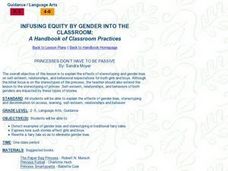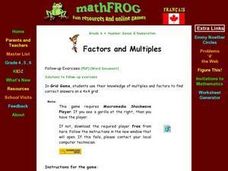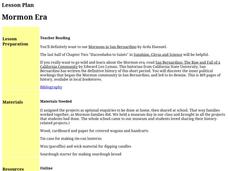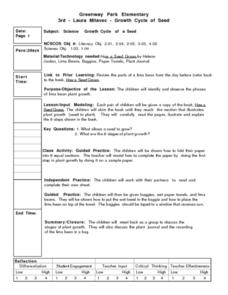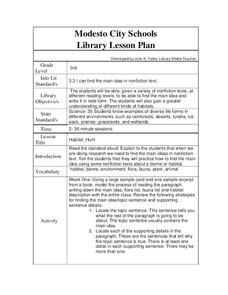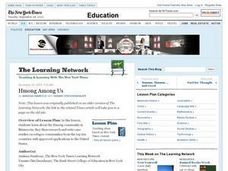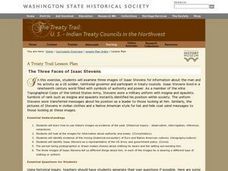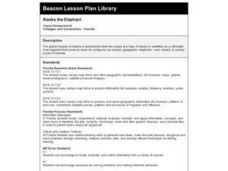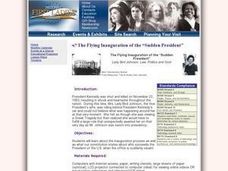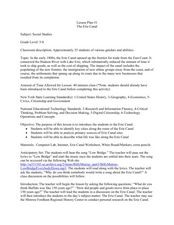Curated OER
PRINCESSES DON'T HAVE TO BE PASSIVE
Students learn the effects of stereotyping and discrimination.
Curated OER
Factors and Multiples
Sixth graders need to see the relevance in the mathematics they learn. This lesson builds on the concepts of least common multiple and greatest common factor. The lesson presents real-world problem situations for students to solve.
Curated OER
Mormon Era
Students learn the history of the Mormons and are able to explore items made during the Mormon era by creating their own by hand. In this Mormon Era lesson, students create covered wagons, can lanterns, candles and sourdough bread as...
Curated OER
Comstock Calamity
Young scholars study the life of miners and complete activities showing what they have learned. In this miners lesson plan, students read about the life of miners and complete writings, posters, quotes, and other activities about the times.
Curated OER
Parts of a Book
Second graders learn to identify the parts of a book. In this book parts instructional activity, 2nd graders learn the names of book parts by participating in a teacher led instructional activity in which they look at transparencies....
Curated OER
Online Public Access Catalog
Fourth graders learn how to find books in the library. In this library activity, 4th graders observe how to use an online system to search for a book by title, author and subject. Students practice searching for books.
Curated OER
The Lima Bean
Third graders investigate the life cycle of a seed. The parts of a lima bean are presented as part of a review. They identify the parts of the seed and state different stages as seen in observation. Students also use an illustration to...
Curated OER
Friendly Letter: CLOZE
In this writing worksheet, students learn to write a friendly letter about where they live. The letter has a CLOZE format to guide the beginning writer.
Curated OER
Habitat Hunt
Third graders read several nonfiction texts and practice finding the main idea for the text as well as learn about various habitats. In this main idea lesson, 3rd graders read several nonfiction texts and make habitat cards. Students...
Curated OER
Hmong Among Us
Young scholars examine the Hmong community in Minnesota, then research and write case studies on refugee communities from the top ten countries with approved applications to the U.S. They write first-person stories from the perspective...
Curated OER
Keeping Us in Stitches Activity: Hexagon Quilt Top Design
Students examine how the hexagon shape can be a building block for quilt patterns. They view images of quilts, discuss symmetry and design patterns, and create and name an original quilt design.
Curated OER
The Three Faces of Isaac Stevens
Eighth graders examine three images of Isaac Stevens for information about the man and his activity as a US soldier, territorial governor and participant in treaty councils. Students are also shown Union Army pictures with different...
Curated OER
Paving the Road to the Constitution
Eighth graders assess the strengths and weaknessess of the Articles of Confederation as related to the United States and North Carolina. They demonstrate an argument for or against ratification of the United States Constitution.
Curated OER
Truman's Foreign Policy Decisions
Students examine foreign policy decisions of former President Truman which still affect us today, review factors to be considered in making foreign policy decisions, closely explore specific major foreign policy decisions, and share...
Curated OER
Keeping Us in Stitches Activity: Interviewing a Quilter
Students investigate the process of quilting. They conduct Internet research, brainstorm and develop a list of questions to ask quilters, and interview a quilter about the process of making a quilt.
Curated OER
Using the Internet to Learn About Marine Life in our Area
Students explore how living things interact with their environment. They research marine life that is studied by Mote Marine Laboratory. Students track sick and injured marine animals. They explore the red tide and the geography of Florida.
Curated OER
Alaska the Elephant
Students explore an Internet website, locating and matching the shape of an elephant's head to a state in the U.S. They complete an Alaska worksheet, identifying other geographical locations surrounding Alaska.
Curated OER
Immigration Push and Pull Factors
Eighth graders examine significant ideas, beliefs, and themes; organize patterns and events; and analyze how individuals and societies have changed over time in Maryland, the United States, and the world.
Curated OER
A "State of the Arts" Coin K-3
Students recognize the U.S. penny, nickel, dime, and quarter by design, size, and denomination and that the portraits and other images depicted on the coins were designed by artists. They study common Texas symbols and choose one to draw...
National First Ladies' Library
The Flying Inauguration of the "Sudden President
Students study the inauguration process as well as what the constitution states about who succeeds the President of the US when the office is emergently vacant. They discuss the role of government and the events leading to Lyndon...
Curated OER
The Eerie Canal
Young scholars discover bodies of water in the United States by investigating the Eerie Canal. In this U.S. Geography lesson, students discuss Lake Eerie and the canal that was built in order to transport goods. Young...
Curated OER
Scientists and Statesmen in Early America
Explore the historic and cultural context of the foundations of the United States of America. They identify the political and scientific contributions of early American scientists.
Curated OER
Personal Learning Profile
Students are given an overview of their legal rights according to IDEA, each student describes in their own words why it is important that they exercise their rights within the transition planning process. They are asked, "What can...
Curated OER
Learning from Artifacts Uncovering Clues, Large and Small
Pupils observe artifacts from Fort St. Louis at a website in order to make inferences about the people who lived there. They paint pottery in the style which might have been used by one of the cultural groups who inhabited the fort.
